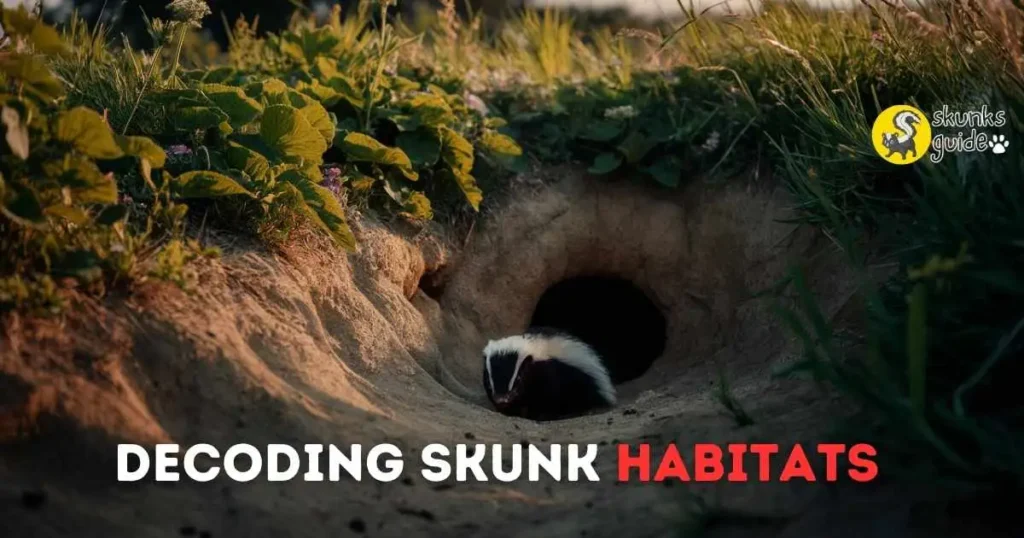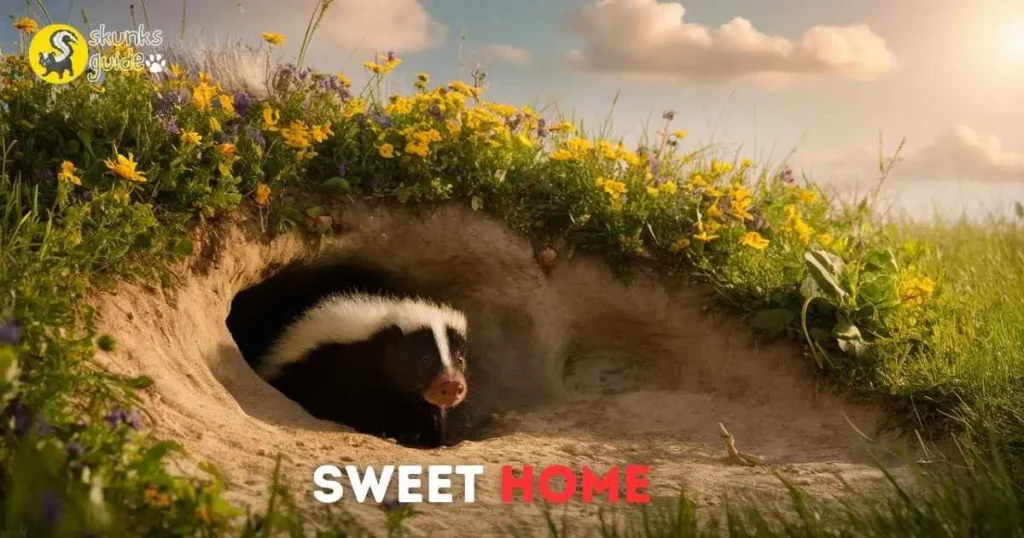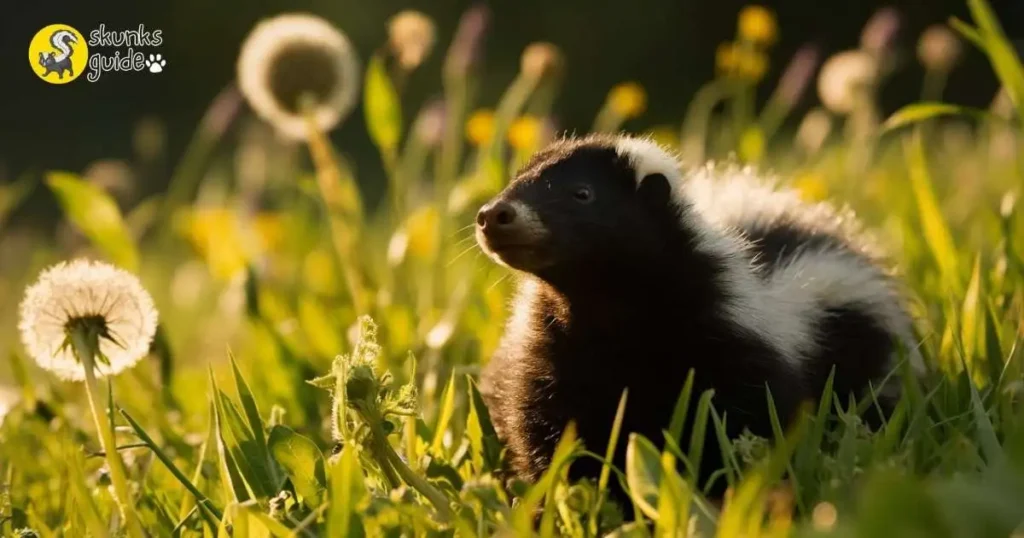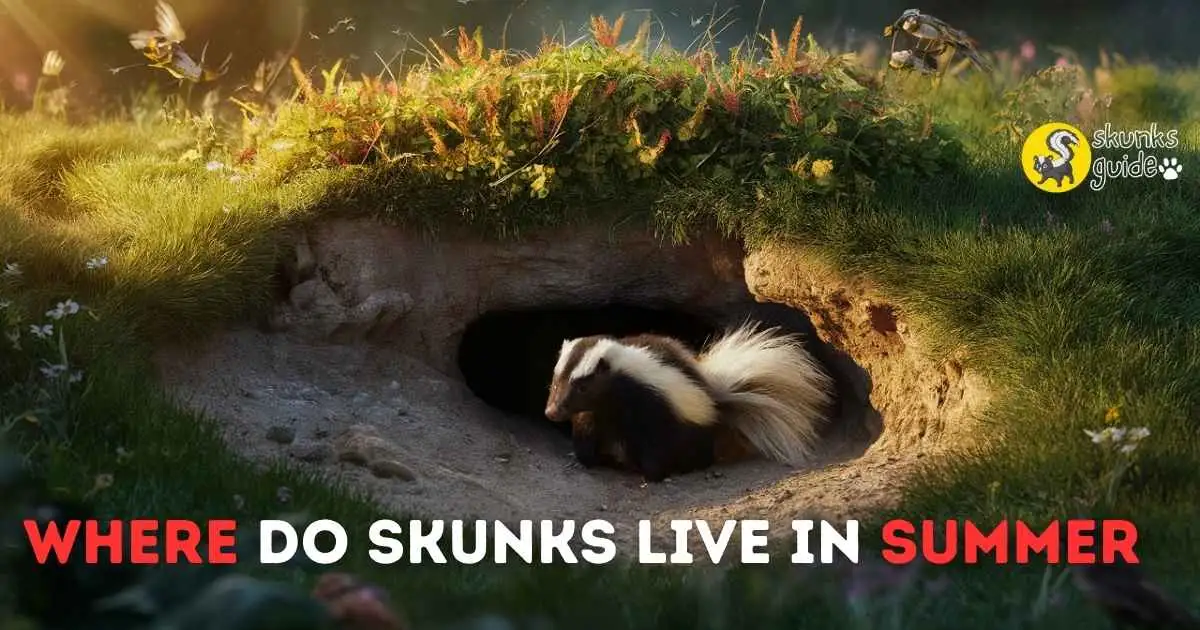Where Do Skunks Live in Summer?
Skunks love staying in places like forests, grassy fields, and even neighborhoods when the weather gets warmer. As someone who studies skunk wildlife, I’ve learned they look for spots with lots of food and shelter. Stick around to find out how these smelly critters choose their summer homes and how it affects the areas they live in!
Skunks’ Summer Hideouts
Skunks find various places to stay cool during summer. They prefer spots that offer safety and shelter. Understanding their hideouts helps us appreciate these unique creatures.
Natural Preferences
In nature, skunks choose specific areas for their summer homes:
- Wooded Areas: They love dense forests and thickets.
- Grasslands: Open fields provide plenty of food.
- Underground Burrows: Skunks dig or use existing burrows.
These natural habitats give skunks protection from predators. They also help them stay cool during hot days.
Human-proximate Habitats
Skunks often adapt to living near humans. They find food and shelter in urban areas.
- Gardens: Skunks enjoy eating fruits and insects.
- Trash Bins: They rummage through garbage for leftover food.
- Basements: Some skunks enter homes through open doors or vents.
In suburban neighborhoods, skunks can thrive. They blend into their surroundings and stay hidden.
Decoding Skunk Habitats
Understanding where skunks live in summer helps us appreciate their role in nature. Skunks are adaptable creatures. They thrive in various environments, making them fascinating to study.

Geographical Range
Skunks are found across North America. Their habitats stretch from Canada to Mexico. Here’s a quick look at their geographical range:
| Region | Common Skunk Species |
|---|---|
| Canada | Striped Skunk |
| United States | Eastern Spotted Skunk |
| Mexico | Hooded Skunk |
Skunks prefer areas with plenty of food and shelter. They often inhabit:
- Forests
- Grasslands
- Suburban neighborhoods
- Farmlands
Adaptation To Environments
Skunks are excellent at adapting. Their black-and-white fur acts as a warning. This helps them avoid predators. They also have strong digging skills. This allows them to create homes underground.
During summer, skunks seek cooler areas. They often choose:
- Wooded regions
- Areas near water sources
- Dense shrubs for hiding
Skunks primarily eat insects, fruits, and small animals. Their diet influences their habitat choice.
Understanding skunk habitats is key. It shows how these animals fit into our ecosystem. Protecting their homes helps maintain balance in nature.
The Seasonal Shift
As seasons change, so do the habitats of skunks. In summer, these animals adapt to warmer weather. Their living spaces shift, and their activity levels increase. Understanding these changes helps us appreciate their behavior.
Winter Dens To Summer Spaces
During winter, skunks seek shelter in dens. These dens provide warmth and safety. Common locations for winter dens include:
- Underground burrows
- Under rocks
- In hollow trees
- Within abandoned buildings
As the weather warms, skunks move to summer spaces. They prefer areas rich in food and shelter. Summer habitats often include:
- Wooded areas
- Grasslands
- Gardens
- Near water sources
Skunks often venture into urban areas for food. They search through trash cans and gardens. This shift helps them find abundant resources.
Activity Patterns In Warmer Months
Skunks become more active during summer. They forage for food at night, when temperatures are cooler. Here are some key activity patterns:
| Time of Day | Activity Level |
|---|---|
| Dusk to Dawn | High |
| Midday | Low |
In summer, skunks eat various foods. Their diet includes:
- Fruits
- Insects
- Small mammals
- Birds’ eggs
These food sources help them prepare for winter. Increased activity allows skunks to build fat reserves. Understanding their summer habits aids in wildlife management.
Sweet Home
Skunks have unique homes that suit their needs. In summer, they seek cozy, safe places. Understanding their living conditions helps us respect their space.

Burrow Construction
Skunks prefer to dig their own burrows. They use their strong claws for this task. Here are some key points about their burrow construction:
- Depth: Usually 2 to 3 feet deep.
- Size: About 6 to 8 inches wide.
- Materials: Leaves, grass, and soil.
They may also use abandoned burrows from other animals. This saves time and energy. Skunks often line their homes with soft materials for comfort.
Choosing The Perfect Spot
Location is vital for skunks. They look for places that offer protection and food. Here are some ideal spots:
| Location Type | Features |
|---|---|
| Wooded areas | Lots of cover and food sources. |
| Fields | Open spaces for foraging. |
| Suburban neighborhoods | Access to gardens and trash bins. |
Skunks prefer areas with minimal human disturbance. They avoid loud and bright places. A good spot offers safety and easy access to food.
Skunk Real Estate
Skunks are experts in finding cozy homes during summer. Their choice of habitat plays a big role in their survival. Understanding their “real estate” preferences helps us know where to spot them.
Territory Size
Skunks are territorial animals. They need enough space for food and shelter. The size of their territory can vary.
- Male skunks: 1 to 2 square miles
- Female skunks: 0.5 to 1 square mile
These territories help skunks avoid conflicts. They mark their areas with scent. This scent communicates their presence to others.
Inter-species Neighbors
Skunks often share their habitat with other animals. They coexist peacefully with many species. Here are some common neighbors:
| Animal | Relationship |
|---|---|
| Raccoons | Share food sources, no major conflicts |
| Opossums | Mutual benefits, scavenging |
| Foxes | Occasional competition for food |
| Groundhogs | Common burrow neighbors |
These animals have different habits. Skunks adapt their behavior around them. This helps maintain harmony in their shared environment.
Safety And Shelter
In summer, skunks seek safe places to live. They need shelter from predators and harsh weather. Skunks prefer areas with plenty of cover. Thick bushes and tall grasses provide good hiding spots. These habitats help them feel secure.
Predators And Threats
Skunks face several predators. These include:
- Owls
- Foxes
- Coyotes
- Domestic dogs
Young skunks are especially vulnerable. They often lack the skills to escape. Adults use their strong sense of smell to detect danger.
Protective Features Of Habitats
Skunks choose habitats that offer protection. Key features include:
| Feature | Description |
|---|---|
| Dense Vegetation | Provides cover from predators. |
| Burrows | Safe places to sleep and hide. |
| Water Sources | Supports their diet and hydration. |
These features help skunks thrive. They stay hidden and safe from threats.
Human Encounters
Summer brings skunks closer to human habitats. They search for food and shelter. This leads to increased encounters with people. Understanding these interactions helps us coexist peacefully.
Backyard Visits
Skunks often explore backyards in summer. They come for various reasons:
- Searching for food
- Finding shelter
- Exploring new environments
Common food items skunks enjoy include:
| Food Type | Example |
|---|---|
| Fruits | Berries, apples |
| Insects | Grubs, beetles |
| Pet food | Dog or cat food |
Skunks are nocturnal. They are most active at night. This can surprise homeowners. Keep trash cans secured to avoid attracting them.
Skunk Control And Coexistence
Coexisting with skunks is important. Here are some tips for skunk control:
- Seal entry points around your home.
- Remove food sources from your yard.
- Use motion-activated lights.
Respect skunks’ space. They rarely attack unless threatened. If you spot one, stay calm. Back away slowly to avoid startling it.
Skunks play a role in the ecosystem. They control insect populations. Appreciate their presence while taking steps to keep them at a distance.
Conservation And Protection
Skunks play an important role in our ecosystem. Protecting their habitats helps maintain balance. Summer is crucial for skunks as they find food and shelter. Conservation efforts ensure their survival.

Impact Of Urbanization
Urbanization affects skunk populations in many ways:
- Loss of natural habitats.
- Increased road traffic.
- Higher pollution levels.
- Reduction in food sources.
As cities expand, skunks lose places to live. Roads create dangers for skunks. Pollution can harm their health. Less food leads to weaker populations.
Efforts To Safeguard Skunk Habitats
Many organizations work to protect skunks. Their efforts include:
- Creating wildlife corridors.
- Restoring natural habitats.
- Educating communities about skunks.
- Implementing wildlife protection laws.
Wildlife corridors help skunks cross roads safely. Habitat restoration brings back food sources. Education reduces fear and misunderstanding of skunks. Strong laws protect skunks from harm.
| Conservation Efforts | Benefits |
|---|---|
| Wildlife Corridors | Safe passage for skunks |
| Habitat Restoration | More food and shelter |
| Community Education | Less fear, more understanding |
| Wildlife Protection Laws | Legal safety for skunks |
Frequently Asked Questions
Where Do Skunks Stay During The Day?
Skunks typically stay in burrows, dens, or underbrush during the day. They prefer dark, secluded areas for resting. These nocturnal animals emerge at night to forage for food. Skunks often use abandoned burrows from other animals or create their own underground homes.
Do Skunks Come Back To The Same Place?
Yes, skunks can return to the same location, especially if they find food or shelter there. They are creatures of habit and may revisit familiar areas. Securing food sources and blocking entry points can help deter them from coming back.
What Attracts Skunks To Yard?
Skunks are attracted to yards by food sources like pet food, garbage, and fallen fruit. They also seek shelter in dense vegetation, under decks, or in burrows. Keeping your yard clean and secure can help deter these animals from visiting.
Why Do I Keep Smelling Skunk In My Yard?
You might smell skunk due to nearby wildlife. Skunks often wander into yards, especially at night. They spray when threatened, leaving a strong odor. Check for any signs of skunk activity, like tracks or dens. If the smell persists, consider contacting Wildlife Control for assistance.
Conclusion
Understanding where skunks live in summer helps us appreciate these unique creatures. They thrive in diverse habitats, from forests to urban areas. By respecting their space, we can coexist peacefully. Observing skunks can offer insights into local ecosystems. Always remember to keep a safe distance and enjoy their intriguing behavior from afar.

